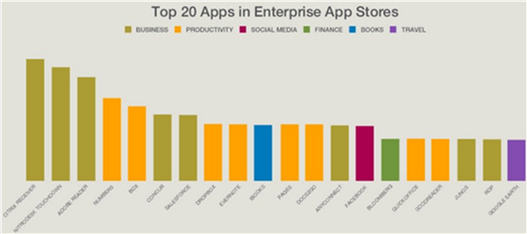How do you managing mobile devices, mobile applications, data, and mobile platforms while meeting security, compliance, regulatory and company standards?
That is a question many CIOs are wrestling with now, and a question that has so many software vendors throwing solutions against the wall to see what sticks in this Mobile Device Management space.
Mobile Device Management (MDM) and now Mobile Application Management (MAM) offerings are fast becoming important topics of conversation for corporate IT departments. Gartner, for its part, is fueling this new space with bold predictions like “65% of enterprises will adopt a mobile device management solution” and that “by 2013 mobile phones will overtake PCs as the most common Web access device worldwide.”
Today there are over 100 companies with a Mobile Device Management offering according to an August 2012 Gartner report entitled “Critical Capabilities for Mobile Device Management”, 42 of which meet Gartner’s criteria to be included in their Magic Quadrant for Mobile Device Management software, with four making it into the golden top-right “leaders” box.
As Gartner is quick to point out, the biggest challenge for companies looking for ways to successfully manage a Bring Your Own Device (BYOD) policy or manage the proliferation of personal mobile devices and services like Dropbox (quietly slipping into the corporate environments) is finding a full featured MDM platform that can address all levels of concern.
According to “Citrix’s Enterprise Mobility Cloud Report” from late 2012, the most common applications deployed in Enterprise App Stores include NitroDesk TouchDown, Adobe Reader, Numbers, Box, Salesforce, Dropbox, Evernote, etc. You can see the full list below.

Left to Right: Citrix Receiver, Nitrodesk Touchdown, Adobe Reader, Numbers, Box, Concur, Salesforce, Dropbox, Evernote, iBooks, Pages, Docs200, AnyConnect, Facebook, Bloomberg, QuickOffice, GoodReader, Junos, RDP, Google Earth
Interestingly, in that same report, the most common blacklisted applications beyond Angry Birds, includes Facebook and Dropbox which just about sums up the fundamental problem.
What you need to know about Mobile Device Management
Fundamentally, there are six basic stages that complete the lifecycle of a mobile device in a corporate environment.

As mobile devices move across the organization and interact with personal and corporate data, IT needs some essential level of control to maintain corporate assets while carefully sidestepping personal device and data issues.
How do you find the right Mobile Device Management platform for your organization?
The ultimate solution you pick for your enterprise needs to address this full lifecycle. Diving a bit deeper, there are several specific tasks and functions needed for a full mobile device management strategy. Gartner divides these into five basic functions, Citrix divides them up into six. Essentially any platform you choose will need to cover each of these areas.

7 Questions to get you started
1. What is your objective? Here are 3 common objectives to consider as you begin to evaluate MDM solutions for your business:
A. Improve the productivity of your end users with mobile devices.
B. Provide a secure mobile platform that lets you deliver on A.
C. Simplify mobile device management so you don’t grind down your IT staff trying to deliver on B.
2. Look for a MDM platform that addresses all of the components your business is going to need as the mobile devices move from initial configuration through to decommissioning.
3. Evaluate the perspective of the MDM platform manufacturer. Are they hanging their hat on their ability to manage the device, manage the applications & data regardless of the device, or manage and measure the performance the end user is experiencing that is actually using the device? Confirm their approach is compatible with your objectives.
4. Look at the application set the MDM vendor is offering. How much change are you going to have to introduce to incorporate their mail client, etc.?
5. How are your end users going to get to their data with their mobile device? Does the MDM vendor have a solution? More importantly, is their solution well thought out and can you integrate their requirements into your environment?
6. What are the requirements and how much will this cost? Is the MDM platform a SaaS model coming out of an Operations budget? Is this a CapEx solution you will have to build out internally? Is there a MSP or hosting partner?
7. Where is your support coming from? Who will be providing the support for your organization?
Don’t forget the missing ingredient that can make or break your mobile ROI – the End User Experience
We as a company spend an enormous amount of time focused on measuring and improving the end user experience for our customers primarily related to Citrix and other virtualization technologies, so, in full disclosure, we are absolutely biased when it comes to evaluating the importance of the end user experience as a metric for any platform.
That said, what good are boxes of new iPads and new BYOD policies if the ultimate end user experience is terrible to the point that no one wants to use it? There are better uses of capital.
When evaluating Mobile Device Management tools take a hard look at how they quantify the end user experience for the IT staff. Can you tell if your end users are having an exceptional experience or if they are ready to smash their devices into tiny pieces out of frustration?
Poor application performance can impact corporate revenues by 9% according to research by the Aberdeen Group. Performance matters.
Aternity for Mobile is how we address this gap in some of the MDM offerings.

Is there lead in that pencil?
Multi-function mobile devices can be great productivity enhancing tools today just like they were approximately 200 years ago with the advent of this piece of new-fangled technology: the pencil.
What was also true then is still true today. If the technology fails to deliver at the Point of Execution, the point of a pencil or that 18” inches between the screen and the end user, does anything else really matter?
A word on MDM tools:
AppSense MobileNow and Citrix XenMobile are two platforms we recommend and sell. We recently did a comparison between Citrix Mobile Solutions Bundle with ShareFile vs AppSense MobileNow & DataNow that you can review here if you would like to read more.






Leave Comment